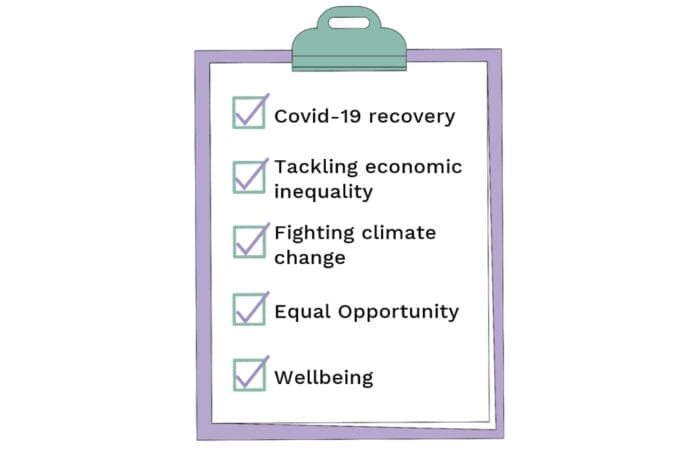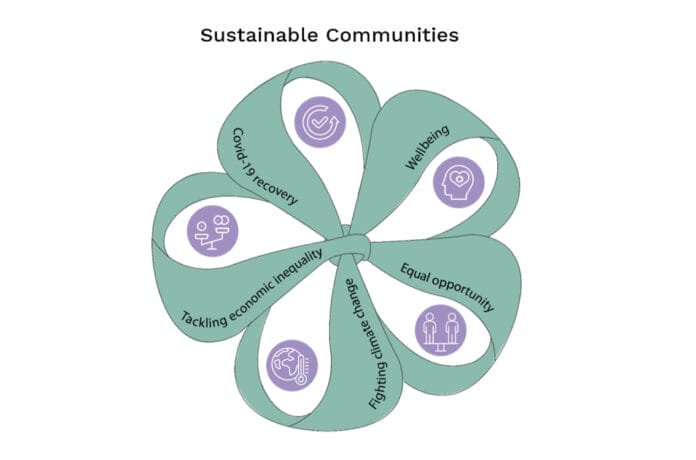
In August, Olivia Jackson took part in the ACES Conference, speaking on social value and how this is as important as an environmental approach to sustainability. Here’s an overview of her presentation, which delves into why we need to approach the topic holistically.
For too long, Social Value has been addressed as a box ticking exercise, whose indispensable nature has been undervalued because of the perception that it is hard to quantify.
For too long, Social Value has been addressed as a box ticking exercise, whose indispensable nature has been undervalued because of the perception that it is hard to quantify. By contrast, sustainability-led projects have risen exponentially in response to the climate-emergency. This siloed approach is not only blinkered but fundamentally unsustainable – a band-aid solution which ignores the fact that our social systems are not structured to support sustainability. We already have the answer – what needs to change is the questions we’re asking.
The 2020 Social Value Model outlines 5 key themes:
- COVID-19 recovery
- Tackling economic inequality
- Fighting climate change
- Equal Opportunity
- Wellbeing
Each of these is critical in creating long-term, well-rounded, sustainable communities.
Thankfully, great progress has been made in terms of recording, measuring and quantifying social value impact. The Social Value Portal has created national Themes, Outcomes and Measures (TOMs); a universally applicable way of measuring and reporting on social value initiatives alongside financial proxy values which allow basic monetisation of both immediate and wider benefits to organisations and communities.


COVID-19, while essentially a global health crisis, highlighted the knock-on effect that crises such as this have on economic, environmental, wellbeing and social mobility – thus enforcing the importance of how each of these is interlinked, and it is only by tackling all 5 at once that we will create truly sustainable communities.
It is rightly becoming a much more commonplace part of all projects and procurement initiatives as a measurable, quantifiable requirement. However, we need to start recognising its true potential, not just as a way of finding socially conscious consultants within procurement, but as unwavering targets which will deliver value for both community and climate.
It is easy to look at the above list and assume that by addressing climate change, we have done right by sustainability, but what that perspective does is to divorce the link between the health of the environment and the health of the community without considering that sustainable solutions cannot survive without the social systems to support them.
COVID-19, while essentially a global health crisis, highlighted the knock-on effect that crises such as this have on economic, environmental, wellbeing and social mobility – thus enforcing the importance of how each of these is interlinked, and it is only by tackling all 5 at once that we will create truly sustainable communities. The good news is that this leaves us with significantly more levers to pull in the fight against climate change. The bad news is that we need to be considering a much wider set of questions as we look to regenerate, recover and reimagine.
COVID-19 recovery – as viewed with a sustainability lens – comes back time and time again to locality, encouraging people that living, working and playing locally is the preferable solution 70-80% of the time. In order to do this we need to understand not only how people use their immediate facilities, but where else they go for things that cannot be found so readily.
What we need to leave at the door is the notion that everyone can do everything, and instead ask ourselves honestly, ‘what do we do well, what do others around us do better and how can we make the combined network as sustainably accessible as possible?’
The 15-20 minute neighbourhood may not be achievable for all localities but understanding and facilitating a network of local businesses across a range of local centres could be firmly within our grasp – after all, why duplicate if we can share and streamline effectively? What we need to leave at the door is the notion that everyone can do everything, and instead ask ourselves honestly, ‘what do we do well, what do others around us do better and how can we make the combined network as sustainably accessible as possible?’ The upshot – not the driver – of this is self-sustaining, sustainable communities built on the foundation of locality.
The discussions surrounding equal opportunity also weigh into this debate and touch on the realm of the Levelling Up agenda. Both respond to the concentration of resource, wealth and population in specific areas and aim to create a more even society where opportunity is accessible at all levels.
On a national stage, levelling up is beginning to be widely acknowledged as new, exciting and able to make a marked difference to an area. On a local level, however, we have yet to emulate or really exude the same principles. Local ‘levelling up’ is typically the domain of community outreach programmes found in community centres, youth clubs, libraries or charitable organisations. These are the facilities struggling to try and deliver accessible opportunity, and yet they are often hidden away in partially forgotten halls, whilst business after business proves that the local high street is not generating viable footfall anymore.
The solution is staring us in the face. We need to take a leaf out of our national book and put our local ‘levelling up power’ at centre stage in our local centres, not only making these community-based facilities more accessible and visible, but capitalising on the universal popularity of these services to generate a more consistent, representative footfall for associated local business.


With the cost-of-living crisis affecting more and more people, the benefits of acting not only to insulate our houses but also our local communities is paramount. The challenge here is addressing change from a social value – and not a sustainability – perspective.
The consequence of this is a sustainable, low carbon retrofit strategy for your local centre – whether that be the high street or a neighbourhood hub – creating consistent patronage, support for the community and ensuring that maintenance, operation and energy efficiency are not only monitored but within your control.
Our project in Staines builds on that very principle – combining healthcare, community arts, fully affordable residential and social recreation in a development which puts equal opportunity at its heart. The apartments have been designed to maximum flexibility allowing for both families and assisted living creating a sustainable, multi-generational community node which has both repurposed existing structures and provides an anchor that draws people into the local centre.
Trailblazers such as the Bromley by Bow centre have pioneered an approach to wellbeing which centres around providing healthcare for ‘life and living rather than disease and illness’. The results are showing that focussing on preventative rather than reactive healthcare creates societies which are better equipped; to make healthy life choices, to support active travel solutions and to contemplate the extremes of the 15-20 minute city without having to use a vehicle. Not only this but it again looks to make the best use of the estates we already have creating carbon neutral solutions to the existing problems of overcrowding without building more energy hungry hospitals. A social value solution for an environmental problem.
With the cost-of-living crisis is affecting more and more people the benefits of acting not only to insulate our houses but also our local communities is paramount. The challenge here is addressing change from a social value – and not a sustainability – perspective.
Our targets, measurements and strategies for environmental sustainability are well reviewed and almost universally applied but we cannot rely on environmental influence alone if we want to win the fight against climate change. Social sustainability is essential and we need to start broadening the discussion to create the same rigour of approach that we apply to carbon neutrality.
Consultation is king (or queen) – it needs to be run at both macro and micro levels and should not focus on questions about sustainability. Instead, it should endeavour to understand where the fault lines in communities have appeared, and how regeneration can help to close these. Without this approach I fear our sustainability strategies become a little like pouring water through a dishcloth – it absorbs some of the information but a significant proportion slips through the cracks and is lost to those who hold it.
Our targets, measurements and strategies for environmental sustainability are well reviewed and almost universally applied but we cannot rely on environmental influence alone if we want to win the fight against climate change. Social sustainability is essential and we need to start broadening the discussion to create the same rigour of approach that we apply to carbon neutrality. Below is our starter for ten questions to kick start a wider conversation around the implementation of the Social Value Model 2020, creating a 360-degree view which will support well-rounded sustainability in the long term.
- ‘what do we do well, what do others around us do better and how can we make the combined network as sustainably accessible as possible?’
- ‘where is the most work being done to ‘level up’ your local community and what can you do to give them more prominence and more presence?
- ‘How can we make healthy living a daily conversation?’
- ‘Are we addressing a social problem with our sustainability hat on?’
- ‘How can we facilitate more consistent community conversations?’



